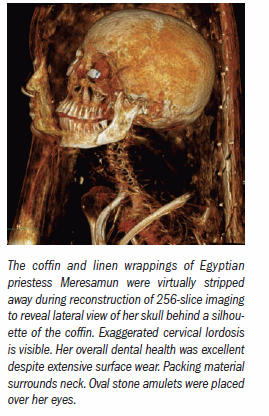Serial mummy scanscapture CT advances
The mummy of the Egyptian priestessMeresamun is helping a radiologistappreciate the recent history of CT withimages that are uncovering mysteriesof a life that ended 2800 years ago.

The mummy of the Egyptian priestess Meresamun is helping a radiologist appreciate the recent history of CT with images that are uncovering mysteries of a life that ended 2800 years ago.
Meresamun and her exquisitely decorated coffin have been examined with CT three times during their long journey from the Temple of Karnak at Thebes to the University of Chicago's Oriental Museum. She was first transported from the museum to the University of Chicago Medical Center for a thorough examination with single- slice CT in 1991. The journey was repeated twice in 2008, first in July for a study with 64-slice CT and, at the urging of radiology professor Dr. Michael Vannier, again in September for imaging with the hospital's new 256-slice scanner.
The most recent studies were performed to aid research for a museum exhibition: “The Life of Meresamun: A Temple Singer in Ancient Egypt.” The detailed color images soon rivaled the mummy itself for starring role in the show at its Feb. 10 opening.
The three exams offer the only opportunities to view the contents of the sarcophagus since it was sealed after Meresamun's internment. It was never opened because museum curators feared damage to her idealized likeness and colorful representations of religious symbols and deities.
Only a few black-and-white images from the 1991 single-slice CT study survive. A single page of observations indicate that 1000 axial slices were acquired during the laborious eighthour session. Researchers found that Meresamun's jaw and a finger were broken. A lump at the neck was thought to be a goiter. Oval stones, possibly amulets, had been placed over her eyes.
Two issues led Vannier to recommend setting aside his 64-slice CT scans of the mummy in favor of 256- slice imaging. First, he learned while evaluating the 64-slice data how to optimize his protocol.
“There is really no literature on 64- slice scanning on mummies,” he said in a phone interview. “You have to just make it up as you go along.”
Second, Egyptologist Emily Teeter and colleagues had posed many questions about Meresamun. Vannier's experience with the Philips Brilliance iCT 256-slice device at the MetroHealth System in Cleveland also convinced him that 256-slice imaging could produce definitive answers.
About 25,000 slices were captured in multiple data sets during an hour of scanning time. Individual scans were completed in 10 to 12 seconds. Individual reconstruction parameters were set for the mummy's head, thorax, pelvis, and lower extremities as well as a scan covering the entire sarcophagus. Some images were reconstructed in a 1024 x 1024-pixel format, with twice the resolution and four times the data of By the time the show opened, the library of reconstructed images had grown to include 100,000 slices.
“Many of the features are discernible at the limits of human vision,” Vannier said. “You would need a microscope to see any finer detail even if you opened the coffin.”

In his analysis, Vannier could find no definitive skeletal evidence of childbearing. He ruled out trauma as the cause of death, suggested by the broken jaw and finger diagnosed in 1991, by finding numerous cracks and fractures that were impossible to see on the single-slice scanner. They corresponded with cracks in dried muslin packed into the thorax and a prominent crack in the coffin itself. The new evidence suggests the coffin had been dropped at some point during its long history, Vannier said.
Archeologists who viewed the images were especially impressed with the priestess's dental status. All of Meresamum's permanent teeth, including wisdom teeth, were present. No cavities or periodontal disease were observed, but heavy wear suggests she had often eaten the gritty stone-ground grains used in temple ceremonies.
The suspected goiter spotted in 1991 scans proved to be an illusion. The 256-slice scans clearly showed that the windpipe and esophagus had been removed during mummification. A great resinous mass of material was placed at that location and covered with skin and shroud. In addition to the two talismans uncovered in 1991, researchers identified many amulets in the folds of wrapping material, mainly around the mummy's head and neck.
Vannier is also providing for future research in ways that were not considered in 1991. Examining the literature led him to conclude that Egyptologists are generally not good at sharing information and that replicating results is difficult. “So we want to give away all these data,” Vannier said.“
Anybody who wants them can have them. We are going through a process now of putting them in a transferable form for dissemination.”
Radiologists attending the 2009 RNSA assembly in Chicago will also have a chance to sample images from the investigation. The exhibit will remain open until Dec. 6.
GE HealthCare Debuts AI-Powered Cardiac CT Device at ACC Conference
April 1st 2025Featuring enhanced low-dose image quality with motion-free images, the Revolution Vibe CT system reportedly facilitates improved diagnostic clarity for patients with conditions ranging from in-stent restenosis to atrial fibrillation.
The Reading Room Podcast: Current Perspectives on the Updated Appropriate Use Criteria for Brain PET
March 18th 2025In a new podcast, Satoshi Minoshima, M.D., Ph.D., and James Williams, Ph.D., share their insights on the recently updated appropriate use criteria for amyloid PET and tau PET in patients with mild cognitive impairment.